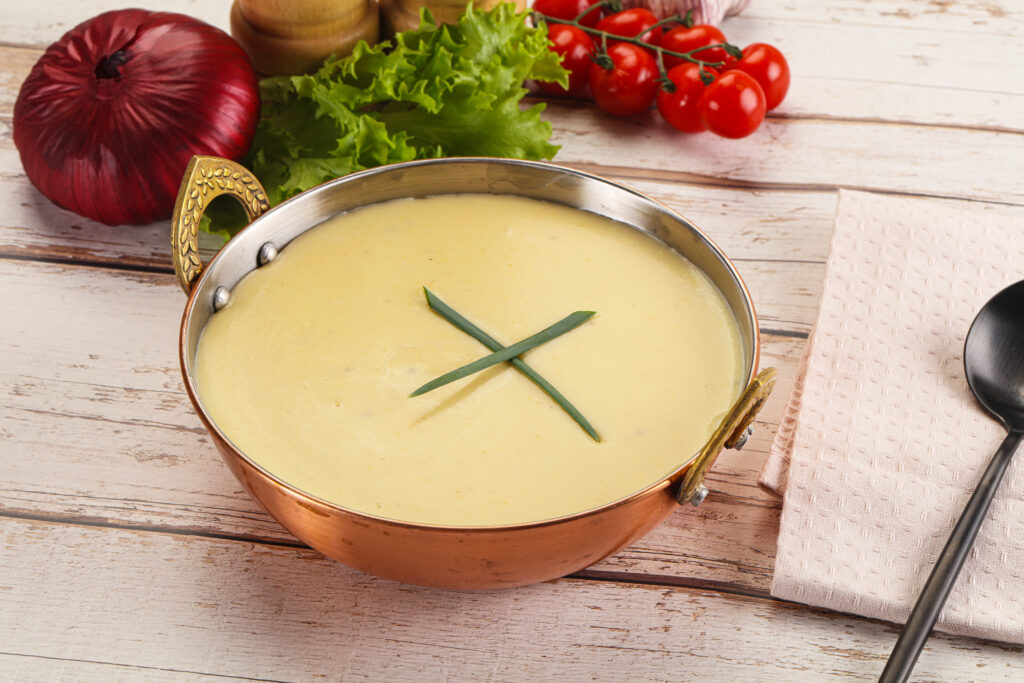
Velouté Sauce: A French Culinary Classic
Velouté sauce, one of the five "mother sauces" in French cuisine, is a light and versatile sauce that is the foundation for countless derivative sauces. Its name, derived from the French word for "velvety," perfectly describes its smooth texture and delicate flavour.
Here’s an in-depth look at the history, recipe, variations, uses, and storage of Velouté sauce, along with insights from Chef Abdul, a culinary expert celebrated for his modern interpretations of classic sauces.
History of Velouté Sauce
Velouté was first codified in the early 19th century by French chef Marie-Antoine Carême, who categorized it as one of the foundational sauces in French cuisine. Later, Auguste Escoffier, the father of modern French cooking, included Velouté in his list of five “mother sauces” in his influential book, Le Guide Culinaire.
Chef Abdul, inspired by these culinary pioneers, emphasizes the timeless elegance of Velouté: “Mastering Velouté is not just about technique but understanding the harmony it brings to dishes—a balance that has stood the test of time.”
Ingrediants
- 2 tablespoons butter
- 2 tablespoons all-purpose flour
- 2 cups white stock (chicken, fish, or vegetable stock)
- Salt and white pepper to taste
Instructions:
- Make the Roux:
- Melt the butter in a saucepan over medium heat.
- Add the flour, whisking constantly, and cook for 2–3 minutes to create a pale roux (do not let it brown).
- Add the Stock:
- Gradually add the warm stock to the roux, whisking constantly to prevent lumps.
- Simmer:
- Bring the mixture to a gentle simmer, stirring frequently. Cook for 10–15 minutes until the sauce thickens and coats the back of a spoon.
- Season:
- Add salt and white pepper to taste. Strain the sauce through a fine mesh sieve for a smooth texture.
Chef Abdul suggests warming the stock beforehand for seamless incorporation: “A warm stock ensures a velvety finish without lumps—a key to perfecting Velouté.”
Uses of Velouté Sauce
As a Sauce Base
- Chicken Velouté: Made with chicken stock, perfect for poultry dishes.
- Fish Velouté: Prepared with fish stock, ideal for seafood recipes.
- Vegetable Velouté: Made with vegetable stock for vegetarian dishes.
Derivative Sauces
- Suprême Sauce: Add cream and lemon juice to chicken Velouté.
- Allemande Sauce: Enrich with egg yolks and cream.
- Normande Sauce: Combine with cream, mushrooms, and a splash of white wine (perfect for seafood).
- White Wine Sauce: Mix with reduced white wine and butter.
- Mushroom Sauce: Sauté mushrooms and add them to Velouté for depth of flavour.
Pairing Suggestions
- Serve over roasted or poached chicken, turkey, or fish.
- Use as a filling for savoury crepes or a base for pot pies.
- Incorporate into vegetable gratins or casseroles.
Chef Abdul adds, “Velouté’s versatility is unmatched—it’s the foundation of creativity in the kitchen.”
Storage and Shelf Life
Refrigeration
- Store Velouté in an airtight container in the refrigerator for up to 3 days.
- Reheat gently on low heat, whisking to restore smoothness.
Freezing
- Freeze in portion-sized containers for up to 3 months.
- Defrost in the refrigerator and reheat carefully to prevent separation.
Tips for Perfect Velouté Sauce
- Stock Quality Matters: Use high-quality, flavourful stock for the best results.
- Whisk Constantly: Prevent lumps by whisking continuously while adding the stock.
- Strain the Sauce: Strain through a fine sieve for an ultra-smooth texture.
- Avoid Over-Thickening: The sauce should be light and velvety, not overly thick.
Chef Abdul recommends experimenting with herbs and spices to personalize the sauce: “Velouté is a canvas for your imagination—let it reflect your unique style.”
Common Variations
- Gluten-Free Velouté: Use gluten-free flour or cornstarch as a roux substitute.
- Herbed Velouté: Add fresh herbs like thyme, parsley, or tarragon for additional flavour.
- Spiced Velouté: Incorporate mild spices like nutmeg or paprika for a twist.
Why Velouté Sauce is a Culinary Classic
Velouté sauce is prized for its subtlety, allowing the flavours of the dish it accompanies to shine. Its versatility makes it a cornerstone of French cuisine. Chef Abdul aptly describes it as “the unsung hero of French gastronomy—a sauce that whispers elegance rather than shouts it.”
Whether you use Velouté as a base for an elaborate dish or serve it with roasted chicken, this classic sauce brings sophistication and flavour to any meal.

